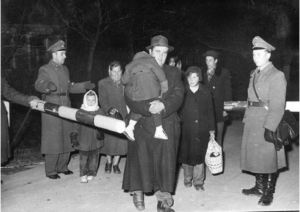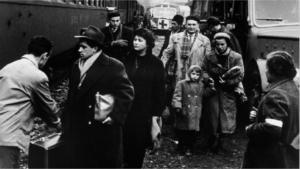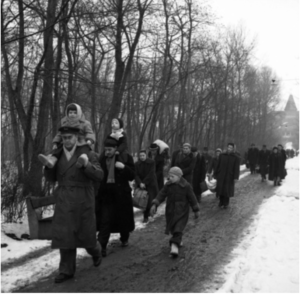
A Human Tide Across the Border
Before the Revolution and before the tide of humanity began streaming across the border between Hungary and Austria, the Austrian Minister Plenipotentiary to Hungary, Dr. Walther Peinsipp, sent a report back to Austria that said, “…the situation in Hungary has become explosive and the opposition is planning to take a considerable risk.“
It was probably the best assessment of the situation by any of the foreign legations in Budapest, and Dr Peinsipp would prove to be correct. The situation exploded on 23 October 1956.
Austria, which had just come out from ten years under Soviet rule, still felt a kinship to the second half of their former Austro-Hungarian empire. By 27 October the Austrian public had mobilized and began collecting humanitarian relief for the insurgents. Between 27 October and 10 November, the Austrian legation would distribute the current equivalent of 1.4 million Euros of humanitarian aid.
The distribution was not smooth – even though the minister himself was delivering supplies to hospitals and the Red Cross via his official vehicle, it came under fire by the Soviets more than once. Later, the Austrians would have to prove, through receipts and witness statements, that they were only distributing humanitarian supplies – the Soviet Union accused them in the United Nations of distributing weapons and tried to levy an official charge of breach of neutrality.
Austria did not limit themselves to humanitarian supplies, though. Not only did they issue passports to some prominent Hungarians, like Anna Kethly, but Austrians actively welcomed Hungarians who managed to make it across their border.

And Hungarians were coming across the border in a tidal wave of humanity. Between 4 and 6 November, the initial days of the second Soviet incursion into Budapest, 10,000 refugees streamed across. By the end of November more than 113,0o0 Hungarians were being housed in refugee camps in Austria. By the time the crisis calmed down, 180,000 refugees had transited through the Central European nation.

The process was certainly not without its difficulties – Austria bore the brunt of the costs and care and made multiple appeals to the United Nations and the world for help; it took some time to gather, but eventually 37 nations responded to the call and began to accept the refugees.
The same can’t be said for the 20,000 refugees who poured across the border with Yugoslavia. Yugoslavia’s position was already precarious; the thawing relationship between the Soviets and Yugoslavs was cooling again after the Yugoslavs granted asylum to the Nagy government and the Nagy government’s subsequent kidnapping and removal to Romania by the Soviets. But still, Yugoslavia’s Tito did not want a full return to the wild days and attempted assassinations of the Tito-Stalin split. The refugees put Tito’s government in a difficult position, and it was a position the West wasn’t eager to alleviate.

As Charles Collingwood said on the Edward Murrow radio show on 19 February 1957, “Seventeen thousand Hungarians escaped to Yugoslavia and they don’t even have hope. The only place any of them have to go to from Yugoslavia is back to Hungary. They are going back across the border to the land they left at a rate of 700 a week. This is not because the Yugoslavs have changed their attitude – they are taking care of them as well as they can – but there is nowhere for them to go. No country has taken any of the refugees from Yugoslavia.“
William Reuter of CARE International also reported low morale in the Yugoslav refugees due to a lack of information and movement, but that they were being cared for in the best circumstances possible – being housed in summer resorts and fed well.
Hungary continued to rage against Austria for the Austrian response to the refugee crisis. At one point in February 1957 the Hungarian government labeled the area around the Austrian legation a Military Restricted area, cordoned off 100 meters and stationed police officers around who arrested every Hungarian who came out of the Embassy and subjected them to interrogation. Bilateral relations between the two nations were at an all-time low.
In the end, most of the refugees had been sent to new homes by the summer of 1957 – with the United States taking more than 38,000 and over 11,000 staying in Austria. Although the Hungarian government had loudly accused the Austrians of refusing to let Hungarians who wished to return home to do so, according to the UN 18,200 Hungarians returned home. Although the Hungarian government had declared that an amnesty was in effect, many of the returnees were identified as insurgents in photos, put on trial, and some were executed.
The world’s quick and welcoming response to the refugee crisis was due in no small part to the fact that the Hungarian Revolution of 1956 was the first international crisis to appear on television. As well, much of the world was carrying feelings of guilt for not doing more to help those fighting and the reports of the fates of those insurgents who stayed in Hungary were horrifying those who heard them. The world was finally deciding it needed to step up and help and it should have helped much sooner, as John F. Kennedy would say in a speech in New York one year after the Hungarian Revolution began:
This is October 23, 1957 – the first anniversary of a day that shook the world – a day that will forever live in the annals of free men and free nations – a day of courage and of conscience and of triumph. No other day since nations were first instituted among men has shown more conclusively, to oppressed and oppressor alike, the utter, inevitable futility of despotic rule. No other day has shown more clearly the eternal unquenchability of man’s desire to be free, whatever the odds against success, whatever the sacrifice required of him.
But October 23, 1956 shall also be permanently etched in man’s history of man as a day of judgment – and of failure. For on that grim and tragic day, and all through the bloody, perilous days that followed, we in the West were unprepared to act effectively, unwilling to act decisively, unable to act with unity. To those who sought help and revolution, we offered only hope and resolutions. To those who begged with urgent hearts and eloquent tongues for deeds to match our words, for actions to match our promises, we offered only the cruel disillusionment of “all assistance short of help.” There were, to be sure, those among us who asked with passionate interest: What can we do? But we knew not what to do.
For our ongoing series on the Hungarian Revolution of 1956, please click here.
- November 13, 2020
- History
